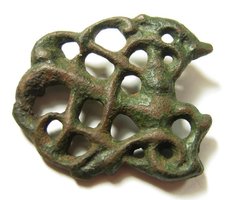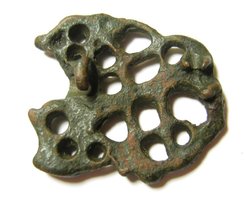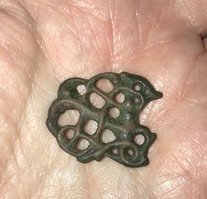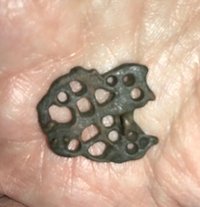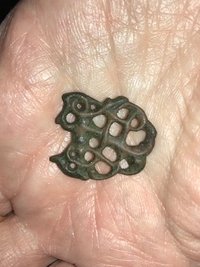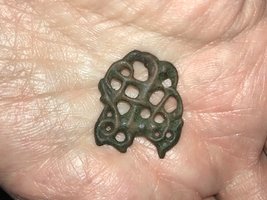Viking brooch in Urnes style
This amazing - complete - bronze viking brooch 28 mm horizontal, 22 mm vertical position, 5.76 grams - in the distinct Urnes style - second half of the 11th century, first half of the 12th century can be placed in one of the most elobarate outings in Viking art. Having been found in Lincolnshire, England, its smart way of casting and devilish detail is telling us that it was made by a Scandinavian. The interlace is puzzling and the longer one looks to it, the more 'hidden beasts' one discovers. For a start: when seen as on the image above, one can recognize a dragonlike head in the right corner above wich entwines further through the brooch, ending in a tail on the bottom. But.. one could easily discover a kind or deer wounded up in the tendrils and facing backwards. Here we are at the true nature of Viking art.It is full phantasy, devilishly thought through though by the artist wo made it. I am deliberately not using the word 'smith' as, looking at this brooch, wouldn't pay homage to him - or her! - enough. Altough cruder casted than other known Urnes style brooches from Denmark and Scandinavia, it is a rare piece of true Viking art, the type and style of object rarely being found in Engeland.
Turning the brooch 45% we can distinguish the dragon even looking like a kind of 'seemonster' seen in a horizontal position. The tail tendrils on the top right even creating an owl like face, creating the two eyes of the owl. Leaning on the jaw of the 'drake' one can use its imagination even further and see the face of a bird, possibly a raven. Turning it another 45% - image 3 - the 'owl face' outlining on the outside becomes a sortalike horse-head-shaped contour. The tail of the snake here seen as a tendril of a plant, wich is both a characteristic of the (late) Urnes and Urnes-Romanesque style. Because of the alignment of the pin lugs and catchplate, the weaer would typically have worn the brooch with the beast snout in the upper right part of the item (with the pin horizontal), but obviously it could be viewed and worn from different directions. Regardless the position looked upon this brooch, the smartness and proportions very much shows to be thought through from every inch and angle. There is no such thing as 'the right side up or down'so it seems. From every angle this brooch is appealing and it almost looks like one has 4 brooches for the prize of 1!
Turning the brooch a final time 45% artificially it seems the animal show calms down and draws to a close. But is it? The owl face hangs in wonder on a tendril, forming a sea horse when one uses some imagination. The head of the dragon - or deer - in this position seems to form another face - the one of a fox or a bat with snout and pointed ears.
Some scholars believe that this type of image - like the famous carving on the North Portal of the Urnes Stave Church at Ornes in Vestvold, Norway - represents Christian man entangled in the evil and sins of the world. Other suggest that it reflects the chaos of Ragnarok, The Norse end of the world.
From every angle, this Urnes style brooch is standing up to all of his silver and bronze Scandinavian examples. A true masterpiece on its own.
See for:
Owen, O. The strange beast that is the English Urnes style (2001)
Webley, R. Still a strange beast? Observations on English metalwork in the Urnes style (2014)
Well. I could have been with these stones until after dark, but as my wife wanted to travel on.. well.. I see you again, some day, hogback stones from Gosforth. And if you happen to be there one day, do not forget that monument on the outside...
Further on with the Cumbrian hogbacktour !
In - yes, luckily again in - St. Peter's church in Heysham, there is a truly beautiful hogback stone. The guide told us, it had been studyied by Thor Ewing, a writer, in 2000. in 'Understanding the Heysham hogback' A tenth century sculpted stone monument and its context (link), Thor Ewing tells in detail what he dicovered on the both sides of this hogback stone.
Just being brought in the church as late as the 1970's accompanied with some protest here and there among the church visitors, considered as being a token of old paganism, it had been remarkably nice preserved, and a lot of detail can be seen, still. Truly worthwile a visit.
I had a small debate with the guide in the church if the - zoomorphic, in my opinion - faces on the sides were lions (or hippo's). The guide doubted if the vikings could have known about lions. Well I guess so, concerning the runes on the Ancient Greek lion statue at the Arsenal, Venice. For example. Vikings did travel south..
But when he told me he was doubting the vikings 'discovered' (as the native inhabitants were of course, in the first place) America before Columbus, I decided to rest my case..
One has to know when to start and to end a conversation ..
Just discovered the book in a bookstore written by Geoff Holder - The guide to the mysterious Lake District, I knew there had to be another hogback stone in Lowther, St. Micheal's Church. With a promising image described in the text of 'a naval and a land-based force of shield-bearing vikings above a fish and what might be a coiled sea serpent. On the reverse is a row of female figures with snakes, possibly a representation of the hideous hag Hel'. Wow. If that did not sound as a true pagan promised land ..
Not complaing too much after all we have seen, this visit was the dissapointing one of them all. But if you wife states 'I am happy to have seen them' and I am answering 'Measuring is knowing' and the even more obligate verb 'handling 'if we did not see it at all, we wouldn't have known anything at all of how they were looking' the glass was again half full, at the last day of our journey..
The hogback stone appeared to be just being tolerated within the entrance segment part of the church. As something you never use anymore but you do not throw away - entirely. That sort of feeling emerged when seeing this hogback asylum seekers.. Bed, bath and bread, ás we say in Dutch, but no luxury at all and standing on some outcuts of wood, you would balance the table with at home..
Come on, St. Micheal's Church.. care a bit more of your 'children' !
This hogback stone was moved in the church in 1907. Hogback stones layed partially buried in the churchyard before it was dug up and moved into the church.
The promising depiction of a longship - as certainly can be seen after some studying - see http://vikingminds.co.uk/pages/longship
we have missed !
The stone itself is (157 x 50 x 30 cm) and very worn.
The hogback stones in Cumbria - very diverse in quality, but everyone worth a visit ! Especially on a gloomy day in late October ...
The churches to visit - see photos of resp. St. Andrew's church in Penrith, St. Mary's church in Gosforth, St. Peter's church in Heysham and St. Micheal's church in Lowther.
Did I miss out on another one in Cumbria ? Let me know !
In a next blog I will take you to four - still remaining utterly mysterious- statues 'guarding' the graveyard of St. Andrew's church in Dacre..
For the last blog of October 9th see this link.
References: (as always, links to where the books can be ordered are attached).
Edwards, B.J.N. Vikings in North West England - The artifacts (1998);
Emery, Gordon, CURIOUS CUMBRIA, The Lake District & Beyond: A celebration of Cumbria (2023)
Ewing, T. 'Understanding the Heysham hogback' A tenth century sculpted stone monument and its context ;
Hall, R. Viking Age archaeology in Britain and Ireland (first printed 1990, reprinted with amendments in 1995);
Holder, G. The guide to the mysterious Lake District (2009)
possibly also (as there within the part of Cumbria dealing with Carlisle, the Eden Valley, Barrow-in-Furness, Whitehaven and the west coast is being dealed with)
Holder, G. Paranormal Cumbria (2010)
http://vikingminds.co.uk/pages/longship
